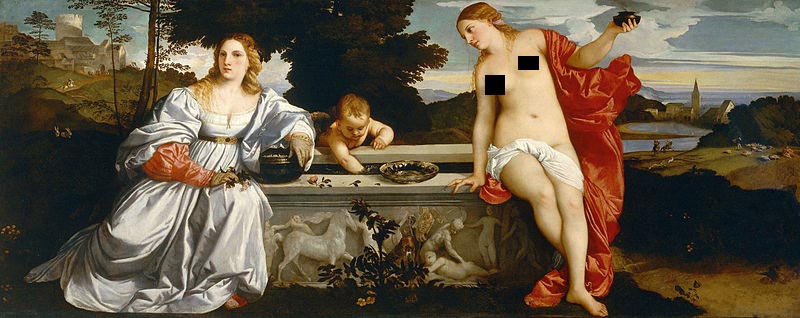| Sacred and Profane Love | |
|---|---|
 |
|
| Artist | Titian |
| Year | c. 1513–1514 |
| Medium | Oil on canvas |
| Location | Galleria Borghese in Rome, Italy |
| Dimensions | 46 in × 110 in |
| 118 cm × 279 cm | |
| Famous Paintings by Titian | |
| Rape of Europa | |
| Sacred and Profane Love | |
| Pastoral Concert | |
| The Assumption of the Virgin | |
| Christ Carrying the Cross | |
| The Flaying of Marsyas | |
| Allegory of Prudence | |
| The Worship of Venus | |
| Self-Portrait | |
| View Complete Works |
Titian painted Sacred and Profane Love between 1513 and 1514. In this painting, an oil on canvas, two women, or perhaps two versions of the same woman, sit on opposite ends of what looks like a marble trough. The woman on the left is almost nude, save for a strip of pure white cloth around her hips and a dramatically breeze-blown red stole. She’s looking beseechingly to the other woman. In one hand she holds up an incense burner. Both women are beautiful, with glowing flesh tones and the flowing reddish blonde hair that was so associated with the painter that women with such hair are called “Titian-haired.”
A Painting Commissioned to Celebrate a Marriage
The other woman wears a voluminous white gown, cinched by a belt with a jeweled buckle. The red of one of her undersleeves matches the red of the semi-nude’s shawl, as does the toe of the slipper that pokes out from under the hem of her gown. She wears leather gloves, and leans on a bowl. She seems to be studiously ignoring the semi-nude woman.
In between them, a cupid fishes through the water in the trough. Behind him is the great, dark mass of a tree which also separates the clothed and semi-nude women. An elaborately decorated bowl sits on the rim of the trough near bits of a rose. The trough itself bears bas relief sculptures of figures from antiquity, and the coat of arms of Niccolo Aurelio, who commissioned the painting to celebrate his wedding. A flowering plant grows before it.
Who’s Sacred and Who’s Profane?
Art historians have been wondering for centuries which of the women represents profane love and which of the women represents sacred love. The background might give a clue. In the background behind the semi-nude woman the viewer sees a church, especially the campanile. A lake separates the church from two hunters on horseback and their dog, who is chasing prey. This also hints that the semi-nude woman is Venus, as Venus was also connected with the hunt. A castle, a symbol of temporal or profane power, is seen in the distance, behind the gowned woman. Another hunter on horseback can be seen on the road to the castle, but between him and the gowned woman are two rabbits, symbols of fertility, if not cupidity. So the puzzle is: who’s sacred and who’s profane?